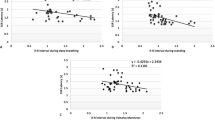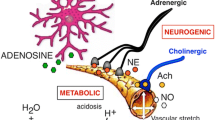Abstract
We compared results from non-invasive autonomic testing [sympathetic skin responses (SSR), heart beat variation during deep breathing, and orthostatic manoeuvre with transcranial Doppler monitoring in 22 patients] with motor and somatosensory evoked potentials (MEP and SEP) in 30 unselected patients with multiple sclerosis. We found a similarly high yield of pathological results for SSR, MEP and SEP (66.7%, 65.5%, and 69%, respectively). When analysed for each limb (n = 120), SSR were highly correlated with MEP and SEP (for bothP < 0.001). Heart beat variation was reduced in only 3 patients. In 4 of 22 patients orthostatic manoeuvre induced a pathological decrease in cerebral blood flow velocity despite normal systemic blood pressure being maintained. We conclude that SSR may be a useful additional diagnostic tool in patients with multiple sclerosis. Cerebral dysautoregulation is a rather frequent finding, although its significance is not known.
Similar content being viewed by others
References
Anlar B, Karaszewski JW, Reder AT, Arnason BG (1992) Increased muscarinic cholinergic receptor density on CD4+ lymphocytes in progressive multiple sclerosis. J Neuroimmunol 36: 171
Busija DW, Heistad DD (1984) Factors involved in the physiological regulation of the cerebral circulation. Rev Physiol Biochem Pharmacol 101: 161–211
Cartlidge NEF (1972) Autonomic function in multiple sclerosis. Brain 95: 661–664
Diehl RR, Daffertshofer M, Hennerici M (1991) Cerebrovascular dysautoregulation: a new syndrome? Ann Neurol 30: 244–245
Edvinsson I, MacKenzie ET (1977) Amine mechanisms in the cerebral circulation. Pharmacol Rev 28: 275–348
Gentiloni N, Schiavoni D, della Corte F, Ricci E, Colosimo C (1992) Neurogenic pulmonary edema: a presenting symptom in multiple sclerosis. Ital J Neurol Sci 13: 435–438
Higashi S, Yamamoto S, Hashimoto M, Fujii H, Ito H, Kogure Y, Tokuda K (1989) The role of vasomotor center and adrenergic pathway in B-waves. In: Hoff JT, Betz AL (eds) Intracranial pressure VII. Springer Berlin Heidelberg New York, pp 220–224
Karaszewski JW, Reder AT, Maselli R, Brown M, Arnason BG (1990) Sympathetic skin responses are decreased and lymphocyte beta-adrenergic receptors are increased in progressive multiple sclerosis. Ann Neurol 27: 366–372
Kurtzke JF (1983) Rating neurological impairment in multiple sclerosis: an expanded disability status scale (EDSS). Neurology 33: 1444–1452
Linden D, Ernst S, Berlit P (1993) Autonomic testing in monofocal brain lesions: topographical aspects of central sympathetic pathways. Electroen cephalogr Clin Neurophysiol 87: S80–81
Moscowitz MA, Sakas DE, Wei EP, et al (1989) Postocclusive cerebral hyperemia is markedly attenuated by chronic trigeminal ganglionectomy. Am J Physiol 257: H1736–1739
Nordenbo AM, Boesen F, Andersen EB (1989) Cardiovascular autonomic function in multiple sclerosis. J Auton Nerv Syst 26: 77–84
Noronha MJ, Vas CJ, Aziz H (1968) Autonomic dysfunction (sweating response) in multiple sclerosis. J Neurol Neurosurg Psychiatry 31: 19–22
Pentland B, Ewing DJ (1987) Cardiovascular reflexes in multiple sclerosis. Eur Neurol 26: 46–50
Poser CM, Paty PW, Scheinberg L, et al (1983) New diagnostic criteria for multiple sclerosis: guidelines for research protocols. Ann Neurol 13: 227–231
Schroth SW, Tenner SM, Rappaport BA, Mani R (1992) Multiple sclerosis as a cause of atrial fibrillation and electrocardiographic changes. Arch Neurol 49: 422–424
Sourek K (1965) The nervous control of skin potentials in man. Rozpr Cesk Akad Ved Roenik 75: 1–97
Thomaides TN, Zoukos Y, Chadhuri KR, Mathias CJ (1993) Physiological assessment of aspects of autonomic function in patients with secondary progressive multiple sclerosis. J Neurol 240: 139–143
Yokota T, Matsunaga T, Okiyama R, Hirose K, Tanabe H, Furukawa T, Tsukagoshi H (1991) Sympathetic skin response in patients with multiple sclerosis compared with patients with spinal cord transsection and normal controls. Brain 114: 1381–1394
Author information
Authors and Affiliations
Rights and permissions
About this article
Cite this article
Linden, D., Diehl, R.R. & Berlit, P. Subclinical autonomic disturbances in multiple sclerosis. J Neurol 242, 374–378 (1995). https://doi.org/10.1007/BF00868392
Received:
Accepted:
Issue Date:
DOI: https://doi.org/10.1007/BF00868392




